Maps and Listings
Map, click here
A good ferry system, a few artfully placed bridges, and excellent roadways link Seattle to the nearby islands, peninsulas, and waterways that surround the city. Day trips can easily extend into longer excursions, with the assurance that all roads – and ferries – lead via a highly scenic route back to Seattle.
Kitsap Peninsula
Some of the islands are developed and have good tourist amenities. Others give a glimpse of the wild without an expedition into the outback. The small, virtually uninhabited Blake Island, for example, accessible only by boat, has a park with 16 miles (26km) of trails and driftwood-strewn beaches. Deer and bald eagles are among the plentiful wildlife.
Blake Island is the location of Tillicum Village. Designed as a tourist attraction in the early 1960s, the village still attracts boats of visitors from downtown Seattle on organized excursions led by Argosy (www.tillicumvillage.com). Visitors can see a Northwest Native American longhouse, lunch on salmon traditionally baked over alder fires, and watch a dance interpretation of local tribal myths and legends. Be aware that the show is more than a little stagey, but the setting is beautiful, especially at sunset.
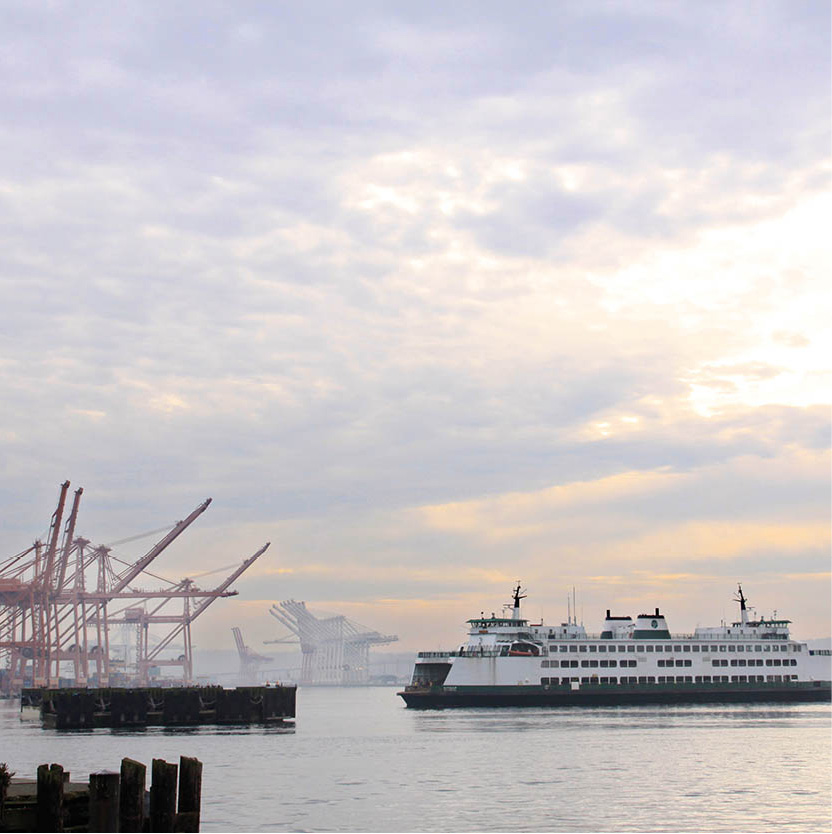
A cruise ship makes its way across Puget Sound.
nathaniel gonzales/APA publication
Nearby Bainbridge Island 1 [map] belongs jurisdictionally to rural Kitsap County (to which it is connected by Route 305), but culturally the increasingly upscale island, with its pricey homes and proliferating BMWs, is closer to Seattle, a pleasant 35-minute ferry ride away. The farmers, fishermen, and wealthy ‘summer people’ from the city who once populated the island are being replaced by Seattle-commuting professionals or wealthy retirees.
At the end of the 19th century, little Bainbridge was home to the world’s largest sawmill, at Port Blakely. Later, the economy turned to berry farming. Many of the farmers were Japanese immigrants – arriving in the 1880s as laborers for the sawmills and later becoming farmers – whose internment in government camps (some in California but most in Idaho) during World War II was vividly described in the 1995 best-selling novel Snow Falling on Cedars, written by Bainbridge resident David Guterson.
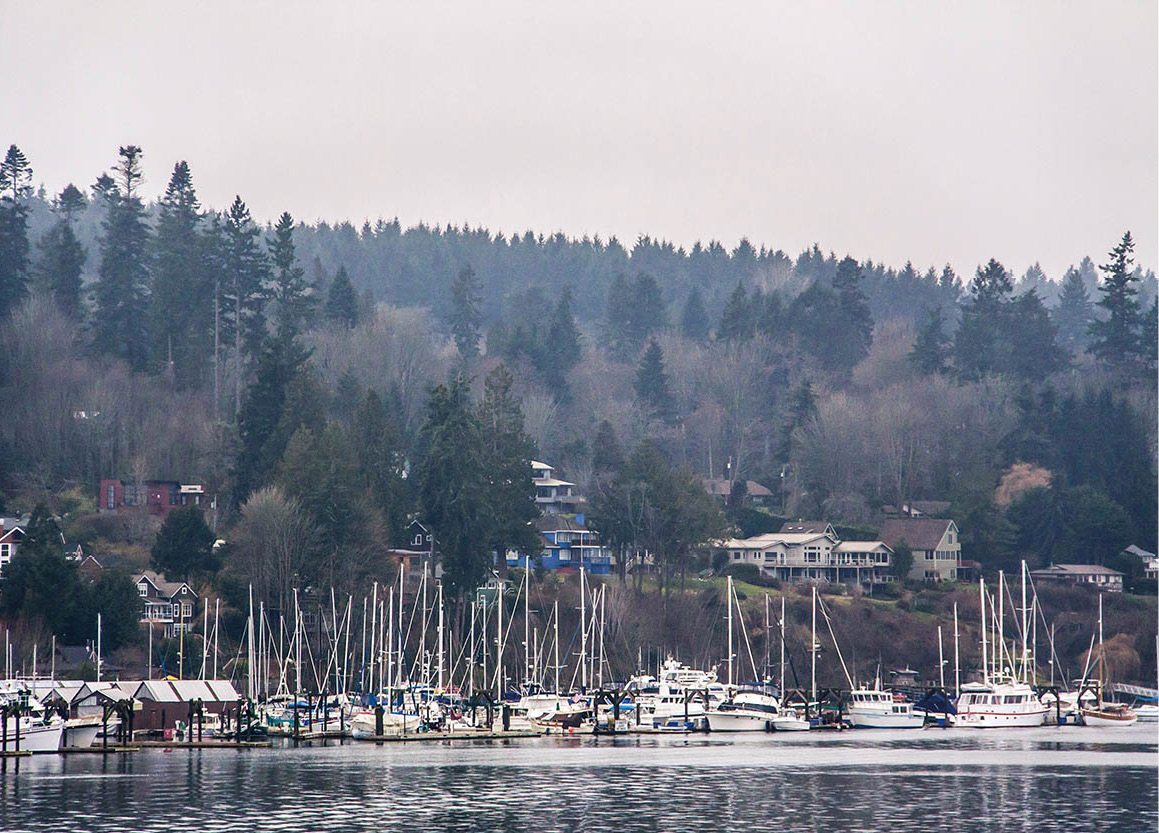
A wintry view from the ferry.
nathaniel gonzales/APA publication
The big berry farms that once anchored the island’s economy are gone, though there are still enough small farms left to justify a strawberry festival put on by the local Filipino-American community. Most of the pretty summer homes have been turned into year-round residences or bed-and-breakfast inns.
Winslow is a tidy cluster of gift shops, cafés, and restaurants. At the Bainbridge Island Library, the Japanese Haiku Garden, part of the library’s attractive grounds, commemorates the island’s issei (first generation) Japanese-Americans. Haiku-inscribed plaques are scattered throughout the stone-and-bonsai garden: ‘Ice and water/their differences resolved/are friends again,’ reads one poem, hinting at the World War II internment.

Houses around the shore.
nathaniel gonzales/APA publication
At the Bainbridge Island Historical Society’s small museum (tel: 206-842 2773; www.bainbridgehistory.org; Mon–Fri 10am–4pm, Sat–Sun 1–4pm; charge), two photographs vividly underscore the impact of the internment on island life.
The photographs show Bainbridge High School’s 1942 and 1943 graduating classes. In the first picture, about one third of the faces are Japanese; the second shows a smaller, all-white class.
Around the island
Most descendants of the issei have moved away for opportunities on the mainland. One who has remained is nursery-owner Junkoh Harui. He restored the nursery, Bainbridge Gardens (9415 Miller Road NE; tel: 206-842 5888), which his father started in the early 1900s from Japanese seeds, and then lost during the internment. The nursery sells an excellent selection of trees, shrubs, perennials, and bonsai, as well as garden statuary. It’s a pleasant place for a stroll.
Take Route 305 north toward the Agate Pass Bridge to the Kitsap Peninsula. Before crossing the bridge you can visit wonderful Bloedel Reserve (tel: 206-842 7631; www.bloedelreserve.org; Tue–Sun 10am–4pm; charge). This extraordinary 150-acre (60-hectare) preserve has woodland, meadows, a bird refuge, and outstanding world-renown Japanese and Reflection Gardens. The leafy expanse makes a perfect wildlife habitat, so bring your binoculars to be on the lookout for eagles, osprey, and hummingbirds. This former summer retreat of a Seattle mayor’s widow – you can also tour their preserved mansion – is a breathtaking daytrip from Seattle.
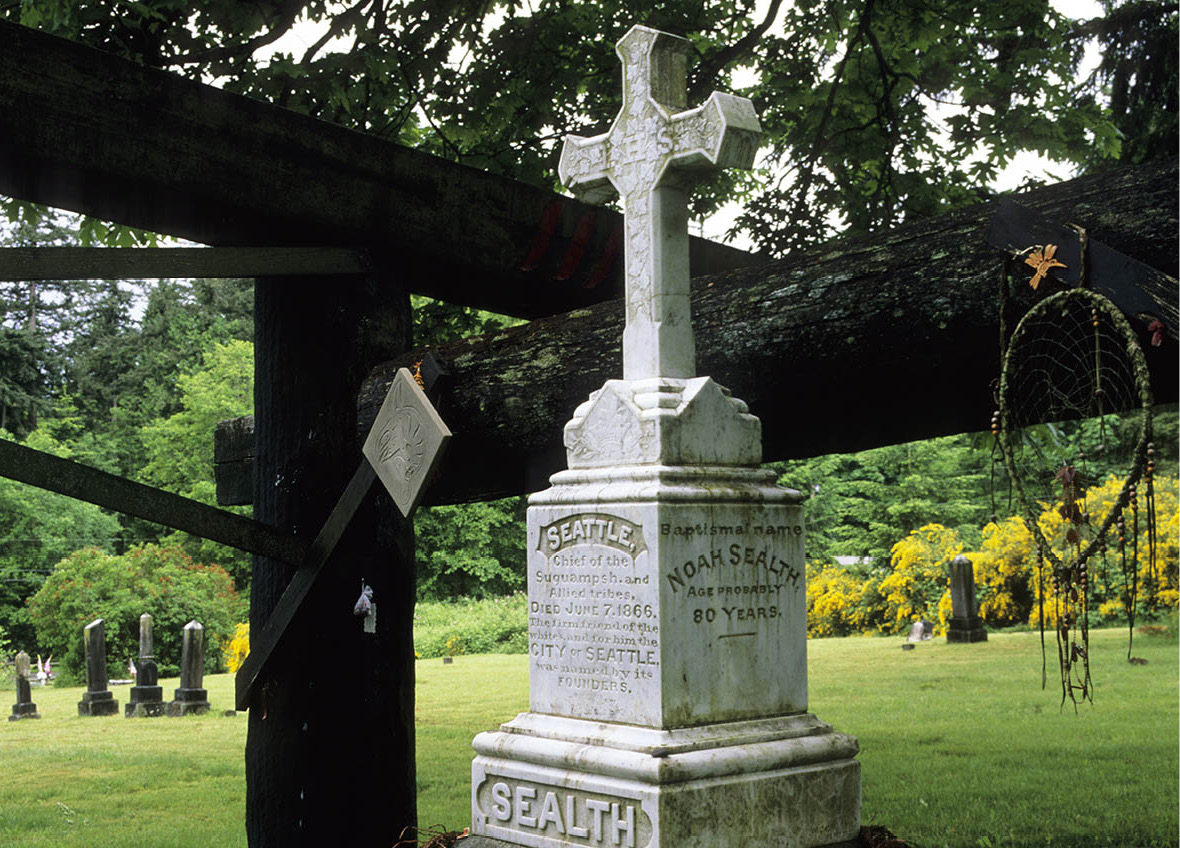
The Suquamish grave of Chief Sealth.
SuperStock
Suquamish
The Agate Pass Bridge onto the Kitsap Peninsula leads to Suquamish, where a right turn on Suquamish Way leads to the grave of Chief Sealth 2 [map], the tribal chief for whom Seattle is named. The tribal cemetery is peaceful and small, but as befits his importance, the leader is commemorated with a tall, white marker. Just up the highway, the renovated Suquamish Museum (6861 NE South Street; tel: 360-394 8499; www.suquamishmuseum.org; daily 10am–5pm; charge) has historical photos and tribal artifacts. The ‘Ancient Shore-Changing Tides’ exhibit recounts the tribe’s history using seven symbolic design elements.
Along Route 305 is Poulsbo, a Scandinavian fishing village turned tourist town. It was nicknamed ‘Little Norway’ for its setting on Liberty Bay, which is reminiscent of the Scandinavian fjords. This may have been the attraction for the Nordic families who emigrated here a century ago. Poulsbo is noted throughout the state for Poulsbo bread, baked fresh daily at Sluys Poulsbo Bakery.
Fact
In June 2005, the Suquamish tribe received the deeds to small Old Man House Park. Chief Sealth had lived on the land, and its return by the Washington State Parks department helped to heal wounds. Old Man House Park is still managed by the department, but under tribal control.
Heading northward toward the Olympic Peninsula is a worthwhile diversion. This takes you to Port Gamble 3 [map], which, until a few years ago, was one of the last lumber towns to have a fully operational mill.
Built by the Pope and Talbot lumber families, who arrived by clipper ship from Maine in the 1850s, the town’s original trading center has been converted into a combination gift store, café, and museum. The tiny town, with refurbished Victorian clapboard houses, is a picture of a prim-and-pretty New England village – but one that is set against a dramatic Northwestern backdrop.
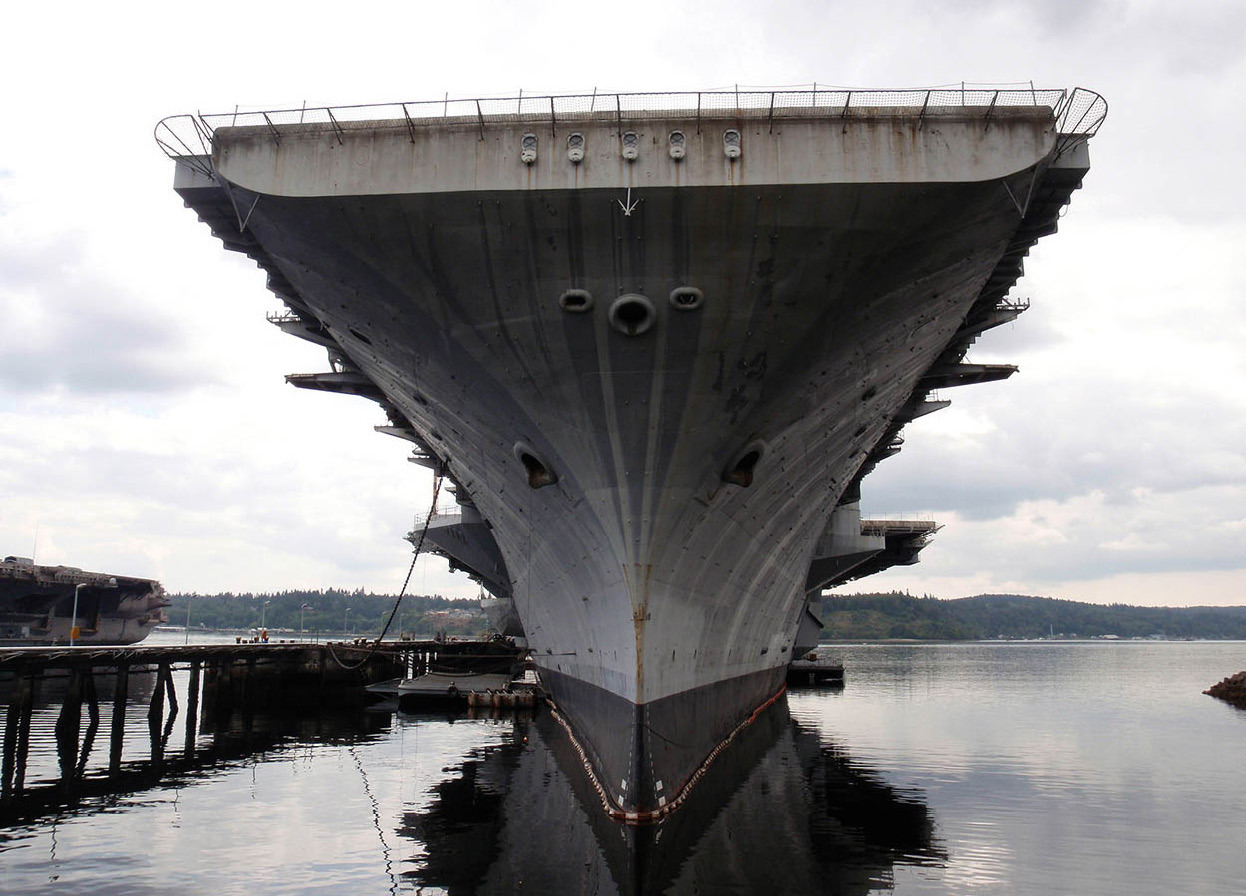
An aircraft carrier in Bremerton.
Bigstock
Bremerton
South from Poulsbo is the seaport town of Bremerton 4 [map]. Founded in 1891 by William Bremer, a German immigrant, Bremerton is one of those towns in the West that for years was controlled by one family. Plotted by Bremer on land he had purchased, the town – today’s downtown area – stayed in the hands of the Bremer family until the second of the two sons died in 1986. Neither son married – according to local lore, in accordance with their mother’s wishes – and after the second son died, local Olympic College inherited most of Downtown.
To the outside world, Bremerton is known for the Puget Sound Naval Shipyard. The shipyard is still a large force in the local economy and culture, but gentrification has brought about a transformation in the town. The result is art galleries, specialty shops, and cafés, mixed in with a few reminders of older days, like tattoo parlors and gritty bars.
The former Woolworth department store has been converted into an indoor antique market, with dozens of vendors proffering a lively assortment of junk and treasure.
The Harborside District is a big, glossy development designed to lure corporations to the town, and with a conference center to attract the business trade. There’s a marina, a boardwalk, fountains, and restaurants.
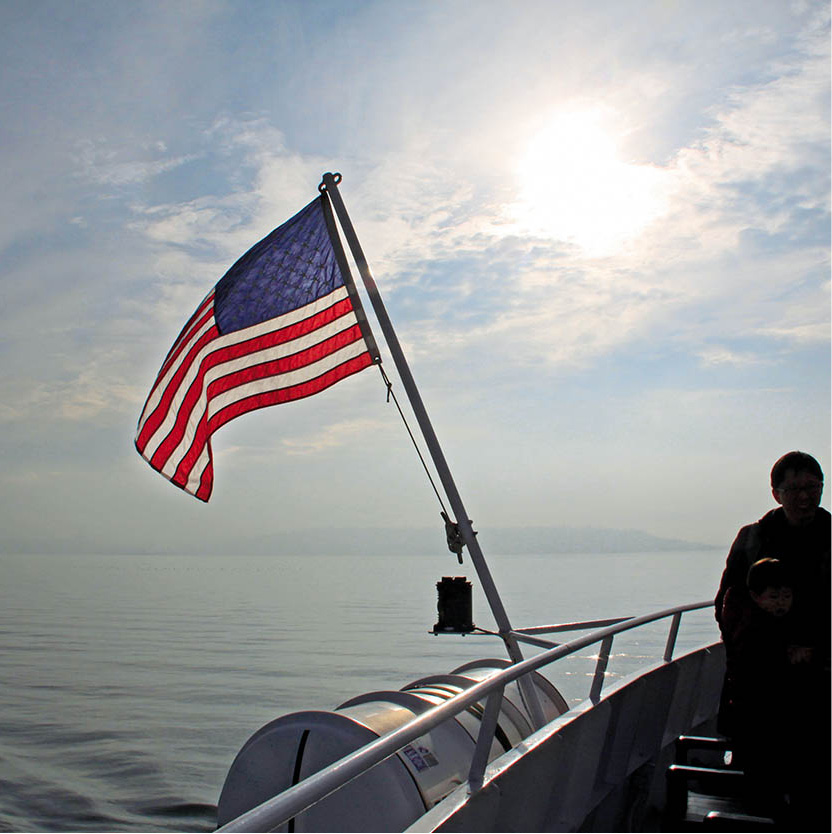
Admiring the view from a harbor cruise.
nathaniel gonzales/APA publication
For years Bremerton’s biggest tourist attraction was the battleship USS Missouri, but Bremerton lost the most highly decorated ship of World War II to Honolulu in 1999. In its place now is an interesting footnote to the Vietnam War: the destroyer USS Turner Joy (300 Washington Beach Avenue; tel: 360-792 2457; Nov–Feb Wed–Sun 10am–4pm, Mar–Oct daily 10am–5pm; charge), which was one of the ships in the Tonkin Gulf incident that escalated the Vietnam War. Nearby is Puget Sound Navy Museum (251 1st Street; tel: 360-627 2270; www.pugetsoundnavymuseum.org; Mon–Sat 10am–4pm, Sun from 1pm; free), which focuses on World War II, and on the shipyard’s contribution.
Mysterious Myths
Myths are plentiful across the waters of Puget Sound and on the slopes of the Cascade Mountains. Sea serpents up to 100ft (30 meters) long with heads like horses and snouts like camels were reported in the Pacific Northwest waters long before the white man arrived. Centuries-old petroglyphs of these creatures adorn rock surfaces, while paintings and wood carvings depict them, too. The creatures were named ‘Cadborosaurus’ by a 1930s newspaperman after sightings in Cadboro Bay, Victoria.
Mountain tales of the elusive Bigfoot or Sasquatch are among the most popular and persistent in North American folk memory. A giant, hairy hominid who roams the forests has been recounted in stories and depicted on totem poles from northern California to British Columbia. Both native and white witnesses describe the creature as 6–11ft (1.8–3.4 meters) tall and weighing between 700 and 2,500 pounds (320–1,100 kg), walking erect or slightly stooped with long arms that swing back and forth. Its hair is black or brown. There is no solid evidence, however, to convince researchers of Bigfoot’s existence.
Vashon Island
Southwest of Bremerton is a ferry link to Vashon Island 5 [map], which is also accessible by ferry from Tacoma, from the Kitsap Peninsula, and from West Seattle (Fauntleroy Terminal). Without a bridge connecting it to the mainland, Vashon remains the most rural and least developed of Puget Sound’s nearby islands, and that’s the way the residents like it.
The island’s easygoing country attitude is symbolized by a famous landmark: the bike in the tree. It seems that, years ago, someone planted a bike in the fork of a tree and left it to rust. Today, the bike is completely engulfed by the tree; it’s still in the woods, on Vashon Highway a few miles south of Downtown, but you may have to ask for directions locally.
Unfortunately, there isn’t enough industry to support the island’s 10,000 residents, so most commute to Seattle or Tacoma. But there are a few who manage to live on the island and work here, too, usually by running one of the small specialty shops. The main culinary draw these days is Sea Breeze Farm’s fantastic onsite restaurant, La Boucherie. They say it best: ‘We farm it, raise it, harvest it, clean it, process it, cook it and serve it.’ Foodies from across the region are boarding ferries to get lunch to go or memorable dinners at this destination eatery.
Vashon is perfect for visitors who like their pleasures low-key. During the summer months, they can pick their own strawberries, rent a kayak, or go swimming. At other times of the year, the main leisure activities include hiking to Point Robinson Lighthouse or taking one of the horse-drawn hayrides.
In the 1960s and 1970s, Vashon was a counterculture retreat. ‘There was only one cop on the island, so you could get away with a lot,’ one alumnus of the era reminisces. Today, intermingling with the locals is a lively community of artists, some of whose work is displayed in New York, San Francisco, and elsewhere, not to mention the galleries scattered across the island.
Vashon Allied Arts, which is headquartered in the Heron’s Nest (17600 Vashon Highway SW; tel: 206-463 5252; www.vashonalliedarts.org), presents a well-attended monthly show featuring local and regional artists.
Fact
Each summer since 1909, the Vashon Island Strawberry Festival has celebrated all things strawberry. The entertainment includes a parade, street dances, classic cars, and the fireman’s water challenge. Back when the festival started, Vashon Island was full of strawberry farms, shipping out more than 120,000 crates a year. Nowadays the farming community is smaller, but features a number of you-pick farms.